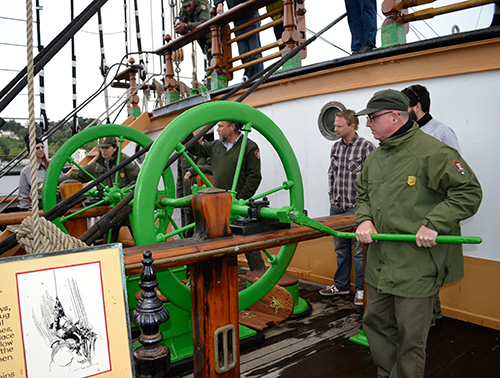-

Win a Free Custom Engraved Brass Coin!!!
As a way to introduce our brass coins to the community, we will raffle off a free coin during the month of August. Follow link ABOVE for instructions for entering.
- Home
- Forums
- Ships of Scale Group Builds and Projects
- Group Build Archives
- Blandford Cross Section PoF Group Build
You are using an out of date browser. It may not display this or other websites correctly.
You should upgrade or use an alternative browser.
You should upgrade or use an alternative browser.
Thanks, Mike!
Mike: Blandford was built in 1720. At that time chain pumps would have been made of wood. Why are Blandford's chain pumps painted black? Is there any reason you know of?
Is it possible that perhaps the pumps were made from lead or copper? The use of lead back then was fairly common. I will leave this here as food for thought, but came across this:
There were basically only three types of ship bilge pump used from the 1400s to the 1800s:
--burr pumps: basically a cone-shaped leather bucket that drew water up a tube
--chain pumps: a continuous chain with small burrs or buckets to catch water and pull it up, running over upper and lower sprockets
--common or “suction” pump: the earliest representation is from 1431. Use on ships was probably from sometime in late 1400s to early 1500s. The first recorded use of metal parts in ship pumps was 1526. Usually they were made entirely of wood until the late 1700s because the only tools available for boring iron tubes were those to make cannon. In 1712, the first practical steam engine was invented by Newcomen. A steam engine needed the piston and cylinder in very tight tolerances. Initially made by hand, ground and filed…further developments in boring machines were needed before steam could progress, and it wasn’t until those machines were made that all-metal pumps could be manufactured.
for the rest of the article.
There were basically only three types of ship bilge pump used from the 1400s to the 1800s:
--burr pumps: basically a cone-shaped leather bucket that drew water up a tube
--chain pumps: a continuous chain with small burrs or buckets to catch water and pull it up, running over upper and lower sprockets
--common or “suction” pump: the earliest representation is from 1431. Use on ships was probably from sometime in late 1400s to early 1500s. The first recorded use of metal parts in ship pumps was 1526. Usually they were made entirely of wood until the late 1700s because the only tools available for boring iron tubes were those to make cannon. In 1712, the first practical steam engine was invented by Newcomen. A steam engine needed the piston and cylinder in very tight tolerances. Initially made by hand, ground and filed…further developments in boring machines were needed before steam could progress, and it wasn’t until those machines were made that all-metal pumps could be manufactured.
for the rest of the article.
- Joined
- Aug 10, 2017
- Messages
- 1,705
- Points
- 538

Hi Dave, I had some black paint I wanted to use before the expiration date.Mike: Blandford was built in 1720. At that time chain pumps would have been made of wood. Why are Blandford's chain pumps painted black? Is there any reason you know of?
Mike
In the AOTS book, the cistern and sprocket wheel covers were clearly made of wood - the legend specifies they were elm. I don't think it would be wrong to leave the chain pumps and pump dales natural wood color. I may add some reinforcement banding to the dales for visual interest, but they weren't subject to a lot of internal pressure as elm tree pumps would have been, so they really weren't needed.
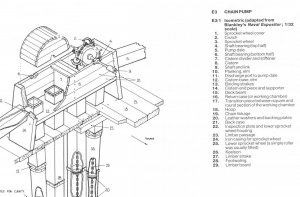
Knut: I think I’ll build the pump of wood- probably boxwood. I’ll include black treenails to simulate nails/bolts. If I don’t like it I can always paint it black!
Mike: I found a problem with the 1:32 scale plans for the main deck framing. The main deck beams on the Part 5 plans dated 2/9/19 are about 3/8" too short in their maximum length compared to the length as shown on the main deck framing plan dated 1/1/18. Maybe I have the wrong set of plans?!?! Photos below.
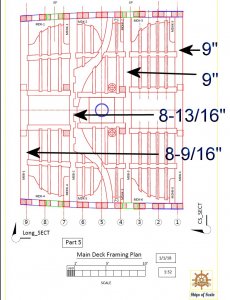
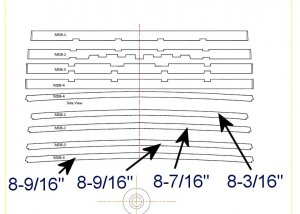


Hi Dave,
I just read this note. The plan on top worked for me I just made it longer. Then I used the patterns for the beam only to get a shape for the beams.
I just read this note. The plan on top worked for me I just made it longer. Then I used the patterns for the beam only to get a shape for the beams.
That's what I'm planning, Mike! Thanks!
This had me scratching my head also. I'm also doing as Stgmik did. I'm working from the center line out. The beam patern doesn't match the plan but it's working out, just have to measure the ledges on the model.
Rather than use the short beam profiles above to draw the finished beams, I started with the beams drawn on the cross section plan at the level of the well. I adjusted the beam slightly for the four locations they occupy on the main deck.
I cut out the four beams for the main deck. The 3/8" wide and 1/4" thick. There is a discrepancy in the plans regarding the main deck beams, so I had to lengthen them to fit. I took my time fitting them in place on the main deck clamp. To make that easier, I modified the ends of the beams. According to the plans, there is a little notch that fits over the top and the face of the clamp. I eliminated the notch, leaving a "flat" - much easier to fit in place.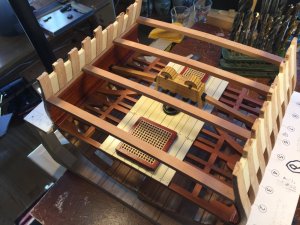
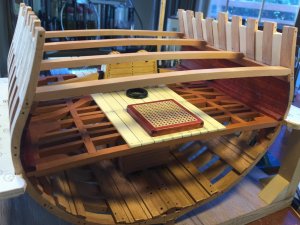
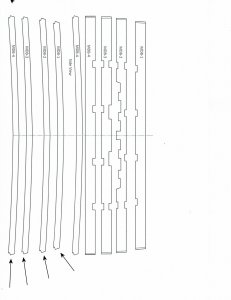
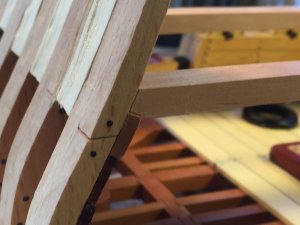




I am second Uwe, very accurately build, Dave!!
Thanks, Eric. I’ll try to post some shots today!
Ahrrr. Eric. I new I could count on you to come up with a history lesson for us.Is it possible that perhaps the pumps were made from lead or copper? The use of lead back then was fairly common. I will leave this here as food for thought, but came across this:
There were basically only three types of ship bilge pump used from the 1400s to the 1800s:
--burr pumps: basically a cone-shaped leather bucket that drew water up a tube
--chain pumps: a continuous chain with small burrs or buckets to catch water and pull it up, running over upper and lower sprockets
--common or “suction” pump: the earliest representation is from 1431. Use on ships was probably from sometime in late 1400s to early 1500s. The first recorded use of metal parts in ship pumps was 1526. Usually they were made entirely of wood until the late 1700s because the only tools available for boring iron tubes were those to make cannon. In 1712, the first practical steam engine was invented by Newcomen. A steam engine needed the piston and cylinder in very tight tolerances. Initially made by hand, ground and filed…further developments in boring machines were needed before steam could progress, and it wasn’t until those machines were made that all-metal pumps could be manufactured.
for the rest of the article.





